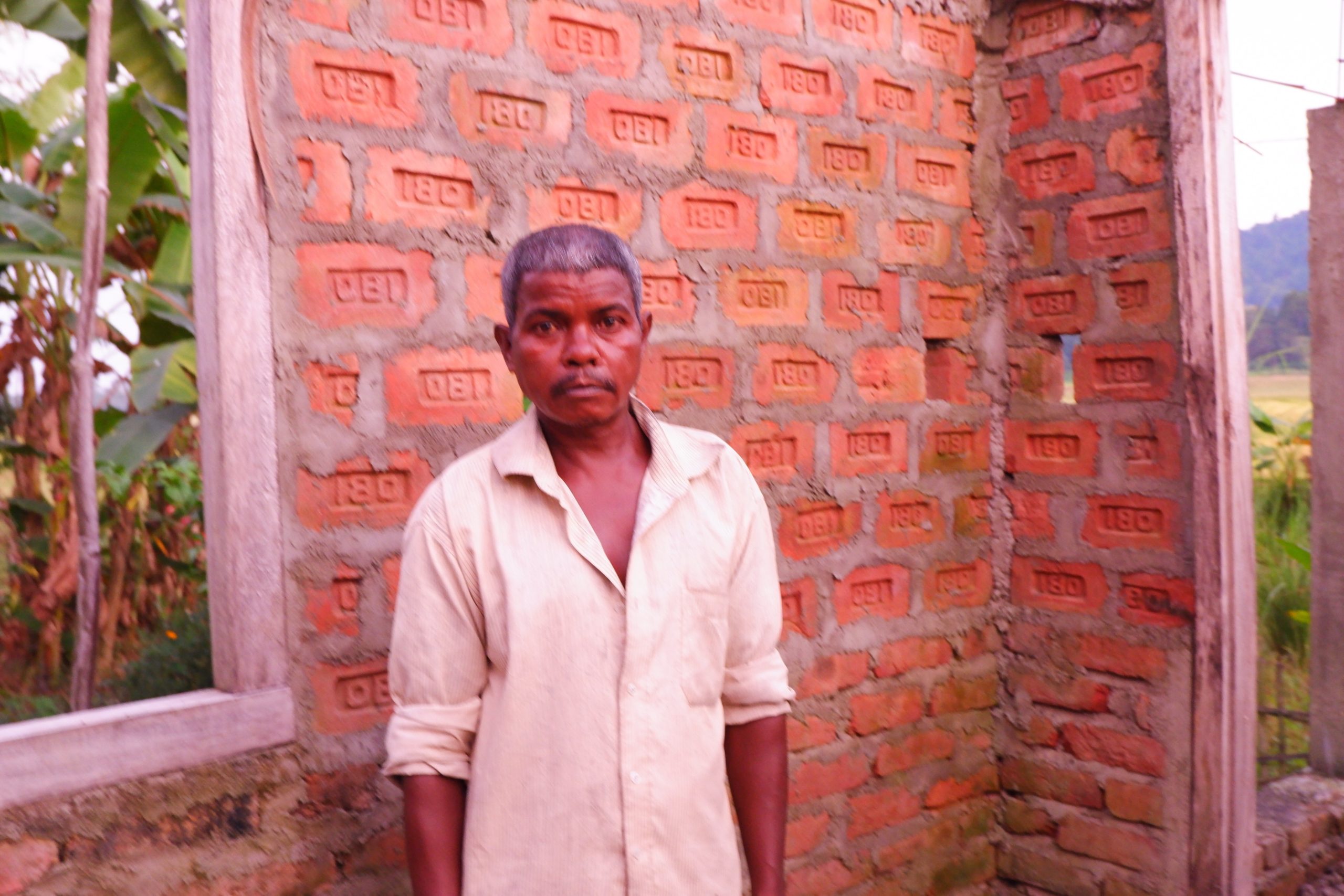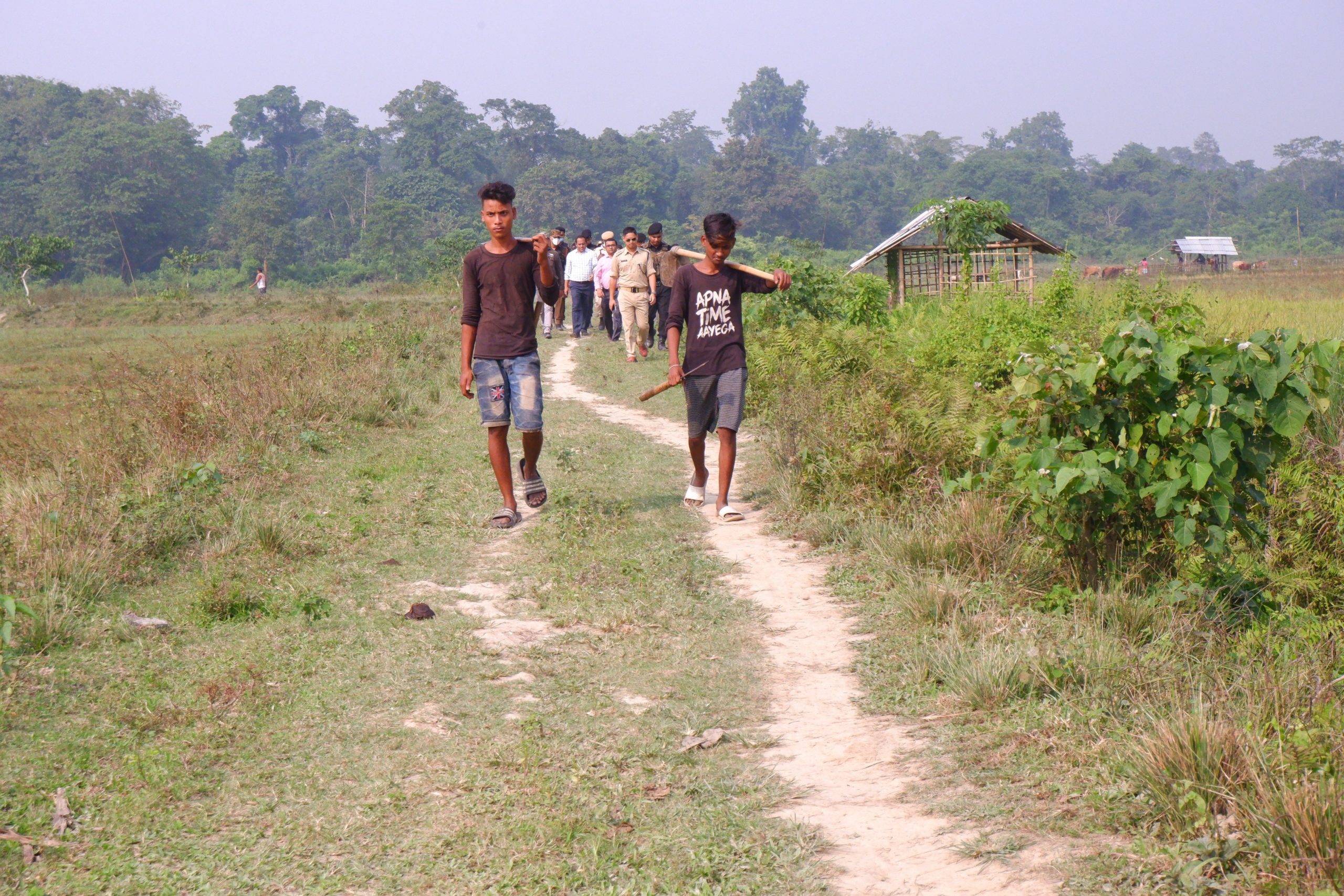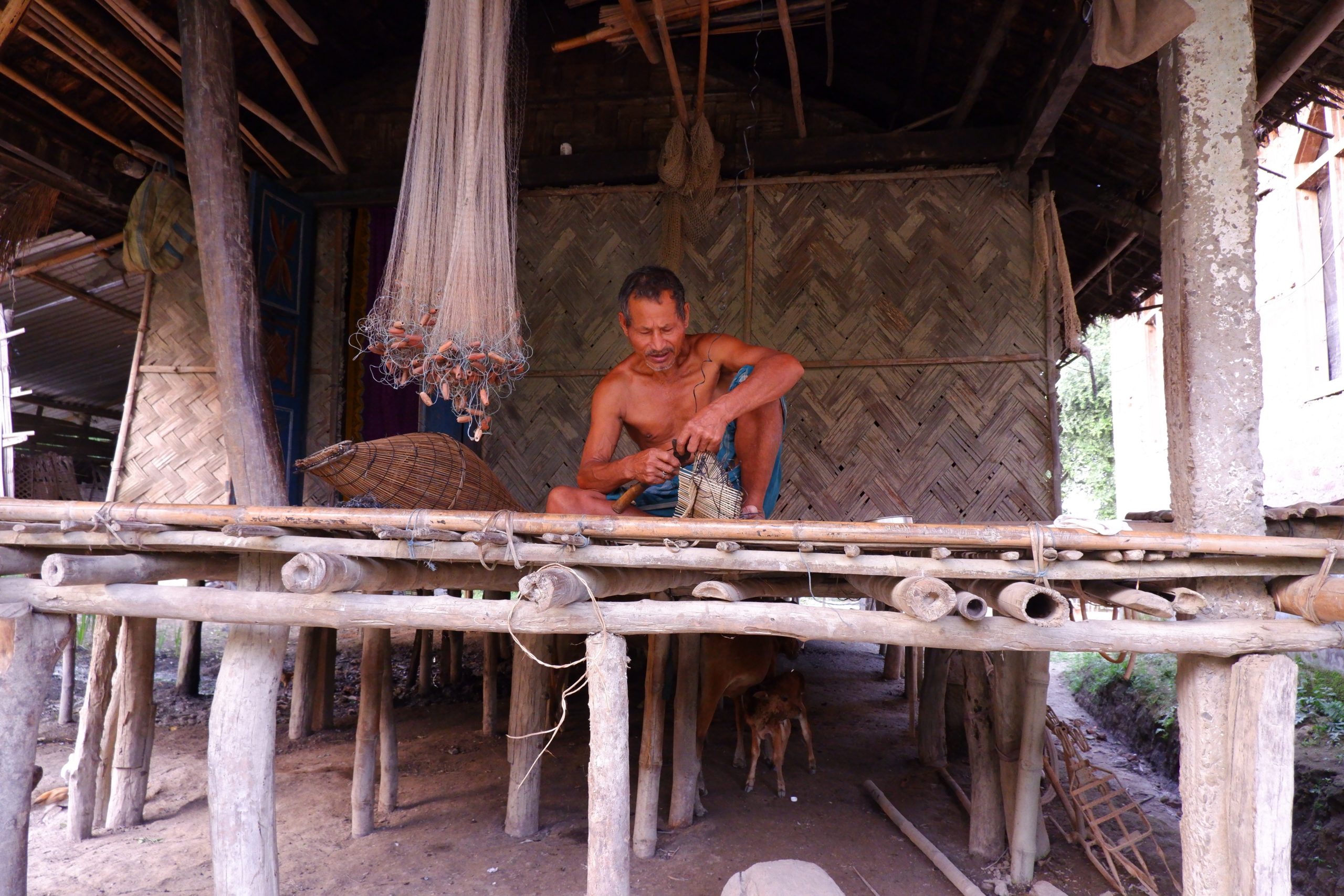Losing Ground: With over 600 families already facing eviction, Assam govt approves another expansion of the Kaziranga National Park, sparking protests
From 429 sq kms in 1977, the Kaziranga National Park has more than doubled to 884 sq kms in 2020. Recently, on September 30, the Assam government approved another 30 sq kms to be included in the national park. Local people face eviction.


Jareena Begum, wife of Yakub Sheikh after vacating her house in Haldhibar, Golaghat district in Assam. Photo: Pratyush Deep Kotoky
Bokakhat, Assam.
All that remains of Yakub Sheikh’s home is a pile of bricks. He along with his wife and son had to vacate their home of 30 years, in Haldhibari, Bokakhat tehsil, in Golaghat district in Assam, 300 kilometres from the state capital Dispur. They have moved to a temporary shelter, not far from their home, on rent. “I have no words to describe the pain of breaking down one’s own home. But we had no other option. If we did not do it, the government would have bulldozed it,” Sheikh, a tailor by profession, told Gaon Connection.
The 50-year-old was served an eviction notice on October 5 by the Bokakhat circle office because his home fell in the area that is to be added to the Kaziranga National Park, a protected area, which is also a UNESCO World Heritage Site. He alleged he was not given any alternative site for relocation and was left to fend for himself. Apart from Sheikh’s family, 48 other families living in Haldhibari and Siljuri in Bokakhat subdivision of the Kaziranga National Park respectively, received eviction notices.
The inhabitants of Siljuri have not moved though they have been served the eviction notice. “We have been living here for decades and earn whatever we can from farming. If they want us to vacate, they have to find us a place where we can resettle,” said Tima Bhowmick, a resident of Siljuri.

“The wild boars and elephants destroy our homes, eat our crops and yet we consider them our own. While the forest department extends no help to us on this matter, they are very prompt in evicting us from our own land and forests with such notices,” Bhaanu Gaur, 35, another inhabitant of Siljuri lamented.
These families face eviction as their villages lie in the areas that are being added to the Kaziranga National Park. From 429.93 square kilometres (sq kms) in 1977, the Kaziranga National Park has more than doubled to 884.43 sq kms in 2020. Recently, on September 30, the Assam government further approved another 30 sq kms to be included in the national park.
This has angered the local people who face a direct threat of eviction from their homes and lands.

The growing park
Kaziranga was declared a reserve forest in June 1908. It was upgraded to a sanctuary in 1916, a wildlife sanctuary in 1950, a World Heritage Site in 1985, a national park in 1974, and finally a tiger reserve in 2007. In 1977, the park covered 429.93 sq km.
The first addition to the Kaziranga National Park was made in 1977 followed by the second, third, fourth and fifth additions in the 1980s and the 90s.
Only recently, in September this year, the state government has approved the seventh, eighth and ninth additions to the national park in order to consolidate the wildlife areas, reduce human-wildlife conflicts, and improve wildlife conservation. As per the seventh addition, 1.76 sq km (176 hectares) are being added in Nagaon district; under the eight and ninth additions, 3.07 sq km (307 hectares) and 25.7 sq km (2,570 hectares) are being added in Nagaon and Sonitpur districts, respectively.
Thus, in a little under 45 years, the area of the national park has more than doubled to over 884.43 sq km, as mentioned by P Shivkumar, director of Kaziranga National Park in its proposal to the seventh addition to the park.
As a consequence of the past additions (till the sixth addition), already an eviction threat looms large over about 662 families, including those from the indigenous communities, from the Kaziranga National Park. Now, 30 sq km more have been sanctioned, and if that happens, more families may be displaced.
Predictably, the local people are enraged. “While we are yet to receive the notice, we know we will be affected by the next round of evictions in our area. But where do we go if the government evicts us from here? Where will they settle us next?” Indeshwar Kutum, a villager of Borbil, Golaghat district, that falls under the second addition to the park, asked Gaon Connection.
The villagers reiterate they are a part of the environment and belong here. “Our crops are often destroyed by wild boars, elephants, or rhinoceros. But we never harm them and regard them as the natural inhabitants of this area, as much as we are. Then why are we being labelled encroachers? We too are an equal and inalienable part of this wilderness of Kaziranga that we revere as our home,” Kutum said.
According to villagers and activists, there have been evictions in the past as more and more additions came under the national park and people were asked to move. But in spite of repeated efforts, no official record on evictions and rehabilitation package offered to the local villagers was made available to Gaon Connection.
When contacted, sub-divisional officer of Bokakhat, Bipul Das, said the eviction drive was as per the High Court order of 2015 and that there was nothing in the court order about relocation.
Ramesh Kumar Gogoi, divisional forest officer, Bokakhat, also declined to comment saying it was a ‘sensitive issue’.
“The fear of eviction is very common in villages which fall under additions to Kaziranga National Park. People still remember the deadly and violent eviction of 2016. We have been opposing eviction since 2016,” Ratan Daw, an activist of Krishak Mukti Sangram Samiti (KMSS), a peasant right organisation based in Bokakhat, told Gaon Connection. KMSS has recently formed a new political party named Raijor Dal.

Bloody eviction and musical chair
In the eviction history of the Kaziranga National Park, 2016 has been a watershed. That year, in accordance with the Gauhati High Court’s October 2015 order, the first eviction drive took place at the Banderdubi, Palkhuwa, and Deusurchang villages located on the periphery of the national park in Nagaon district. Two people lost their lives in the ‘anti-encroachment’ eviction drive. The village inhabitants were forced to scatter. Some who could manage the money bought land in areas that did not come under the ‘additions’, and others moved to wherever they could find a livelihood.
This High Court order was in response to a 2012 PIL filed by Mrinal Saikia, MLA, Bharatiya Janata Party, in which he had raised concerns about poaching and encroachment in Banderdubi, Palkhuwa and Deusurchang villages (Kaziranga National Park vs Union of India and others, 2015. pp. 36-37).
In its order, the High Court had directed the deputy commissioners of Golaghat, Sonitpur, and Nagaon to take expeditious steps to evict those encroaching upon the second, third, fifth, and sixth additions to Kaziranga.
Since 2016, eviction from the national park had slowed down, but recently picked pace again as villagers have been issued eviction notices for additions as old as third and fifth.
While there had been instances of villages being relocated by the government, these were not evictions. “We were originally from Bilotiya Bamun Gaon, a village on the banks of the Brahmaputra. We were resettled in Borbill by the Assam government in 1970-71, when we lost our land to erosion and were given three hundred rupees each as resettlement compensation,” Rampad Kardong, a 65-year-old farmer, now living in Borbill village, told Gaon Connection.

But even though they were moved to Borbill by the government, the very same people are now facing eviction, as Borbill is located a few kilometres away from the Kaziranga National Park’s main entrance, and faces eviction, yet again, as per the 2015 High Court Order.
“Legally, in order to safeguard a national park, there should not be any settlement inside the protected area. But politicians themselves settled people on those lands and allowed them to stay there. Now for political reasons they are trying to evict them,” Mirza Rahman, a Guwahati-based research scholar on borderlands, environment and development issues, told Gaon Connection. He said the issues in Kaziranga had become more political than ecological.
Growing problems
The park’s expansion is also making members of the indigenous Mising community nervous as their villages on the riverine areas of the eastern range of Kaziranga are now threatened by the addition of a new range covering 190 square kms (19,000 hectares) in Bokakhat division of Golaghat district over and above the 884.43 sq kms. This addition has been done vide a 2018 notification. While the Kaziranga National Park has eight ranges in all, the four ranges in its core area that fall under Golaghat and Nagaon district, are Agoratoli, Kohora, Bagori and Burapahar forest range. The Boakhat range is the latest to be added to the national park.
“It is like we are trapped from both sides. On one side we are being displaced by erosion on the river bank and on the other, Kaziranga is like a monster trying to swallow the rest of the meager resources we have,” Ritupan Pegu, a resident of Panbari village, Bokakhat, told Gaon Connection. He said his house stands to be evicted along with many others due to the new range that is now part of the national park. “The government is taking away whatever little we have to make Kaziranga National Park a fortress,” he added.

Protests building up
While fear and uncertainty loom over the inhabitants of villages areas around Kaziranga National Park, Pranab Doley, an advisor with the Jeepal Krishak Shramik Sangha, a peasants’ organisation, called the eviction drive “arbitrary and undemocratic”.
“When the Kaziranga National Park became a National Park in 1974, people here sacrificed their land and livelihood,” said Doley. He also pointed out how the authorities never focussed on scientific conservation that fostered a symbiotic coexistence of humans and wildlife.
Calling the authoritative nature of the expansion as ‘expansionist’ Doley said the matter violated so many codes of the Forest Right Act 2006, that grants certain rights to forest dwellers. “While on paper Kaziranga is expanding, ecologically it is only shrinking,” pointed out Rahman. Kaziranga is being encroached by resorts, roadways and the tourism industry. He accused the politicians of compromising the environment. “The politicians turn a blind eye to all these various businesses coming up in Kaziranga. Instead they are trying to earn political mileage out of it,” he said.
According to Vikram Rajkhuwa, a Guwahati-based lawyer who has been helping in legal fight of the local villagers, “Through ‘addition’ the authorities can include more area to the national park. But legally, any alteration of boundaries of wildlife sanctuary or a national park must take prior permission of the Central government. “Further, they must take permission from the National Board of Wild Life. But it is not clear whether the Forest Department or national park authority has taken any such recommendation from National Board of Wild Life. The High Court in its order in 2015 too observed this,” he told Gaon Connection.
Explaining the issue, he said that there are two important legal aspects which needs to be understood in this scenario, that is, protection of wildlife and the rights of local people.
“In case of a national park, all rights should be extinguished. So, people who have rights such as patta land or other rights must get compensation or provided an alternate land. But in Kaziranga National Park, rights are not extinguished… because though notifications had come earlier, additions are subsequent,” he added stressing on the need for a participatory model where people can be eyes and ears. “Wherever there is a people’s participatory model, it has proved to be more successful,” he said.
Meanwhile, on the same day that Sheikh was handed his eviction notice (October 5), an interactive map was launched by Environmental Justice Atlas, a project that documents and catalogues social conflict around environmental issues. It shows over 13,450 families living inside or close to ‘protected areas’ like national parks and bio-reserves have been displaced in the last two decades in India.

